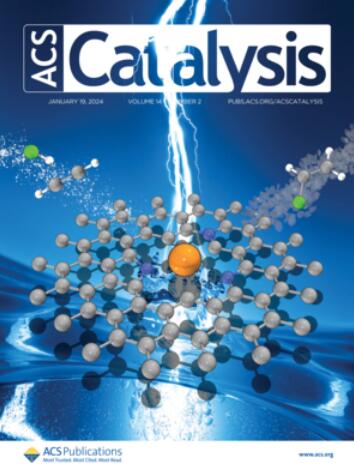A Combined Density Functional Theory and Microkinetics Simulation Study of Electrochemical CO2 Reduction on Ceria-Supported Bismuth
IF 13.1
1区 化学
Q1 CHEMISTRY, PHYSICAL
引用次数: 0
Abstract
Direct electrochemical CO2 reduction (ECR) into carbon-based fuels and chemicals is a promising way to upgrade waste CO2 with renewable energy, contributing to closing carbon cycles and mitigating climate change. Here, we investigate the ECR of Bi–CeO2 catalysts. Using a combination of density functional theory (DFT), artificial neural networks (ANN), genetic algorithms (GA), and microkinetics simulations, we conducted a comprehensive exploration of active sites, the CO2-to-formic acid (HCOOH) mechanism and the electrochemical behavior of Bi密度泛函理论与微动力学模拟相结合的二氧化硅负载铋电化学CO2还原研究
直接电化学二氧化碳还原(ECR)为碳基燃料和化学品是利用可再生能源升级废弃二氧化碳的一种有希望的方法,有助于关闭碳循环和减缓气候变化。本文研究了Bi-CeO2催化剂的ECR。采用密度泛函理论(DFT)、人工神经网络(ANN)、遗传算法(GA)和微动力学模拟相结合的方法,对Bi x /CeO2催化剂的活性位点、co2 -to-甲酸(HCOOH)机理和电化学行为进行了全面的探索。研究了三种具有代表性的模型:(i) Bi原子在CeO2上的吸附(Bi1/CeO2), (ii)单个Bi原子在CeO2表面掺杂(Bi1 - CeO2),以及(iii) 8个Bi原子在CeO2上的吸附(Bi8/CeO2)。采用ANN-GA对CeO2表面Bi8簇的最佳结构进行了识别。我们的研究表明,CO2转化为HCOOH和CO的反应途径多种多样,对于表面含有Bi的结构模型,HCOO转化为HCOOH的途径占主导地位。Bi掺杂在CeO2中有利于COOH途径,导致CO为主要产物。与掺杂模型相比,掺杂模型产生的HCOOH具有更高的电流密度,而掺杂模型主要产生CO。电子结构分析表明,Bi1/CeO2模型中更强的电子赋能通过削弱O-H键和稳定过渡态来增强HCOOH电流密度。我们讨论了电流密度和选择性的动力学差异作为电化学电位的函数。这些发现不仅阐明了不同的CO2转化途径,解释了理想的HCOOH和不需要的CO的形成,而且为电催化剂的设计提供了理论指导。
本文章由计算机程序翻译,如有差异,请以英文原文为准。
求助全文
约1分钟内获得全文
求助全文
来源期刊

ACS Catalysis
CHEMISTRY, PHYSICAL-
CiteScore
20.80
自引率
6.20%
发文量
1253
审稿时长
1.5 months
期刊介绍:
ACS Catalysis is an esteemed journal that publishes original research in the fields of heterogeneous catalysis, molecular catalysis, and biocatalysis. It offers broad coverage across diverse areas such as life sciences, organometallics and synthesis, photochemistry and electrochemistry, drug discovery and synthesis, materials science, environmental protection, polymer discovery and synthesis, and energy and fuels.
The scope of the journal is to showcase innovative work in various aspects of catalysis. This includes new reactions and novel synthetic approaches utilizing known catalysts, the discovery or modification of new catalysts, elucidation of catalytic mechanisms through cutting-edge investigations, practical enhancements of existing processes, as well as conceptual advances in the field. Contributions to ACS Catalysis can encompass both experimental and theoretical research focused on catalytic molecules, macromolecules, and materials that exhibit catalytic turnover.
 求助内容:
求助内容: 应助结果提醒方式:
应助结果提醒方式:


